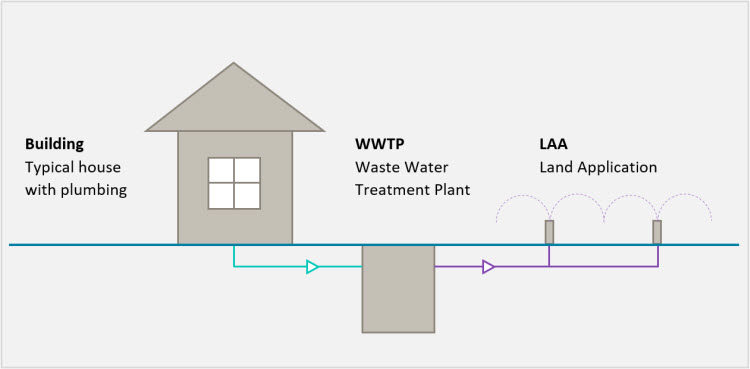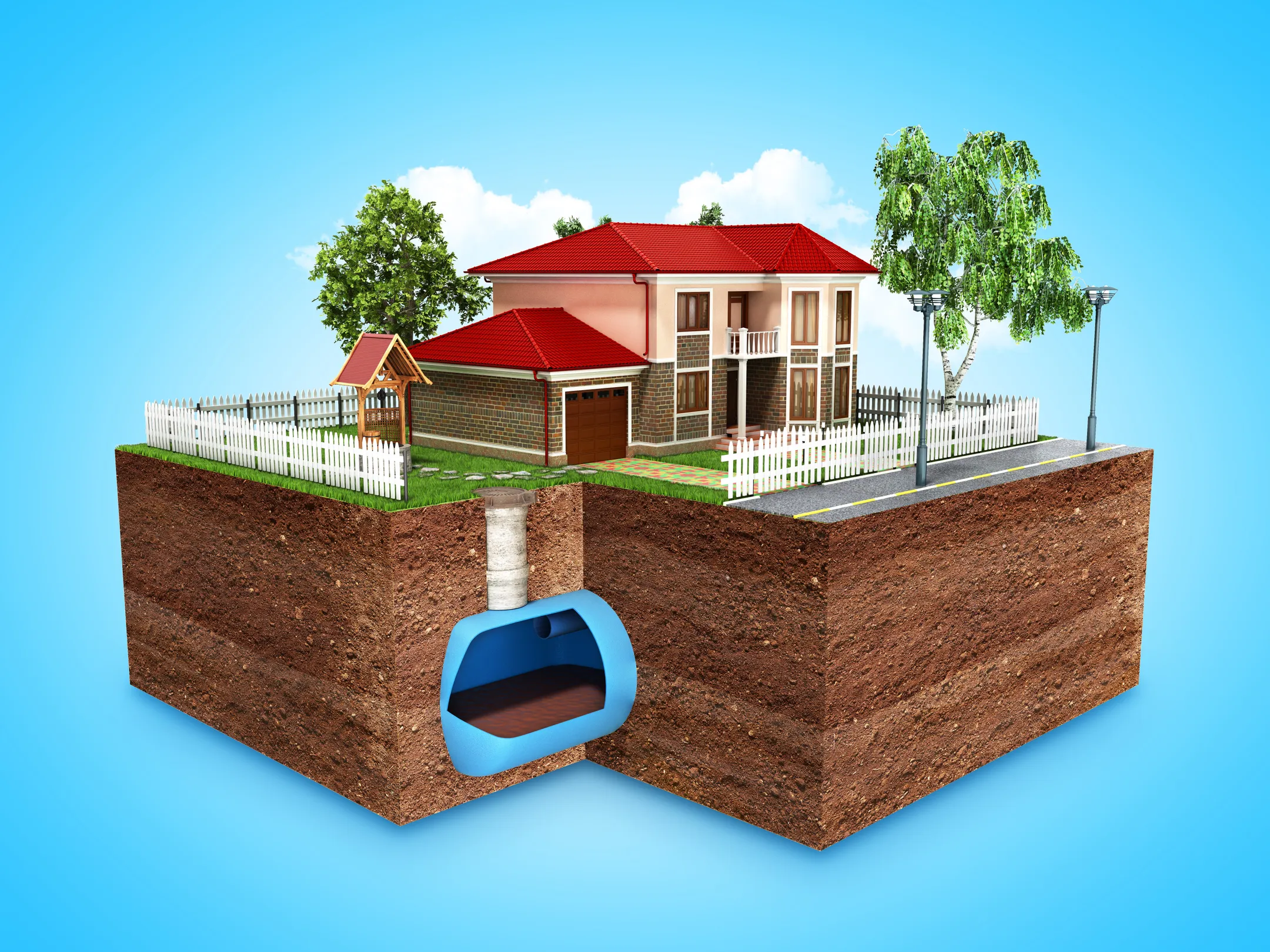On-site treatment and greywater
Information relating to types of household sewerage treatment systems and land application areas.
If your property is not connected to public sewerage infrastructure, you will need an on-site sewerage facility (OSF). This facility stores, treats and disposes of your domestic sewerage on your property. An OSF consists of two components; the treatment plant and the land application area. For a more comprehensive guide refer to council's what is an OSF fact sheet.

All OSF's need a plumbing permit (approval) from council before installation. You need to apply for a permit if you are installing a new OSF or altering an existing system.
To apply for a permit, use form 1 permit work application for plumbing, drainage and on site sewerage work.
Once approved, you will receive a copy of the permit and approved plan. Then a licensed drainage contractor can install the facility. It is the responsibility of the contractor to:
- install the facility correctly
- ensure completion of inspections and certifications
- provide a final inspection certificate to the owner.
Types of on site sewerage systems
See videos about the different types of onsite sewerage facilities.
For more information, see our fact sheets:
Other types of OSF systems include:
- activated sludge
- split black and grey water treatment
- holding tank with pump out
- recirculating sand filter.
For a list of approved systems see the QLD State Government website.
Choosing a system
Choosing a system
Before selecting an OSF, you must have a licensed site and soil evaluator visit the property. They will conduct an investigation and recommend the level of treatment required. There are three common levels of treatment:
- primary treatment - breaks down solid material into liquid waste, then disperses it below ground
- secondary treatment - breaks down organic material to wastewater suitable for surface or subsurface irrigation
- advanced secondary treatment - reduces suspended solids to wastewater suitable for release into sensitive ecosystems.
Factors to consider when choosing a system include:
- soil type of the property
- size and slope of the property
- quantity of water to be treated
- amount of water available
- proximity to waterways
- spread of load throughout the day
- initial cost of system and land application area
- ongoing maintenance requirements
- budget
- Queensland approved treatment plants.
For more information refer to Queensland approved treatment plants.
Land application area
Land application area
A land application area is the area of your property where your treated wastewater is disposed. The design, installation and maintenance of your land application area is important. Each step protects the environment and the health of your family and neighbours.
There are three types of land application areas:
- trench based systems - transpiration to large flat areas with absorbent soils
- surface irrigation systems - disperses using sprinklers, may not be suitable for sloping land
- sub surface systems - disperses using pipes beneath a layer of suspended soil.
Refer to our recommended vegetation to assist land application areas fact sheet.
Maintaining on-site sewerage systems
Maintaining on-site sewerage systems
OSFs need regular maintenance to ensure they operate in a safe and effective manner. Poorly maintained and malfunctioning systems can impact public health, the environment and property value.
Responsibilities of OSF owners:
- make sure the system is well maintained and works properly.
- you may need a service agent agreement to service the OSF. Depending on the system, servicing frequency can vary from quarterly to yearly
- take reasonable steps to keep all plumbing and drainage on the property in good condition
- ensure the system does not create a nuisance or pose a health risk to the surrounding area.
Servicing may include:
- measure sludge and scum levels
- ensure adequate chlorine supplies
- ensure pumps and blowers are operational
- clean filters
- test chemical levels
- check for evidence of bacteria die-off
- check for ponding of wastewater in the land application area
- check mechanical components
- ensure plant is in operational condition
- submitting a service report to council (eServices or manual).
You can further ensure safe operation of your system by:
- avoiding anti-bacterial products and using only septic safe products
- preventing ponding of wastewater in the land application area to avoid spread of sickness
- being alert to any failure of the electrical components of the system
- taking note of any leaking water or broken pipes
- acting on any change in odour coming from the plant
- listening for the correct operation of the system.
Some medications may inadvertently compromise the OSF. For example, chemotherapy medication. Please consult a treatment plant manufacturer or service agent for advise about the potential impact on your OSF.
Decommissioning an on-site sewerage system
Decommissioning an on-site sewerage system
OSFs, including septic tanks must be correctly decommissioned. This is to ensure the tank does not pose a future risk to public health or the environment. A plumbing permit is required prior to any works associated with decommissioning an OSF.
For more information refer to council's septic tank decommissioning procedure fact sheet and sample holding tank installation (DOC, 367KB).
Submitting a service report
Submitting a service report
Service reports provide important information on the performance and maintenance requirements for your OSF. Services reports allow monitoring of your OSF discharges. This ensures it doesn't pose a risk to the environment or health of the community.
Council offers several ways to submit your service report:
- integrating your business system with council's eServices system
- by email or post
- in person at City Hall, 54 First Ave Maroochydore.
Note: an administration fee applies to submission of hard copy and email service reports. Refer to on-site sewerage facilities in the development services fees and charges.
OSF eServices
OSF eServices enables you to directly integrate with council's register. This means we can receive and review your service reports instantaneously.
More information
Making a complaint about on-site sewerage facilities
Making a complaint about on-site sewerage facilities
Contamination of waterways should be reported to council immediately.
Reports of odour problems are also investigated as odours can indicate system failure.
For more information refer to council's OSF responsibilities and complaints fact sheet (DOC, 456KB).
To report a problem contact council's development services.
More information about OSF
More information about OSF
Fact sheets:
- greywater re-use in sewered areas (DOC, 264KB)
- helpful hints for OSFs (DOC, 245KB).
Videos:
- diversion mounds, view the transcript
- troubleshooting, view the transcript.
Featured
eServices
Use council's plumbing eServices system for submitting routine inspection reports for on-site sewerage facilities and backflow prevention devices.

